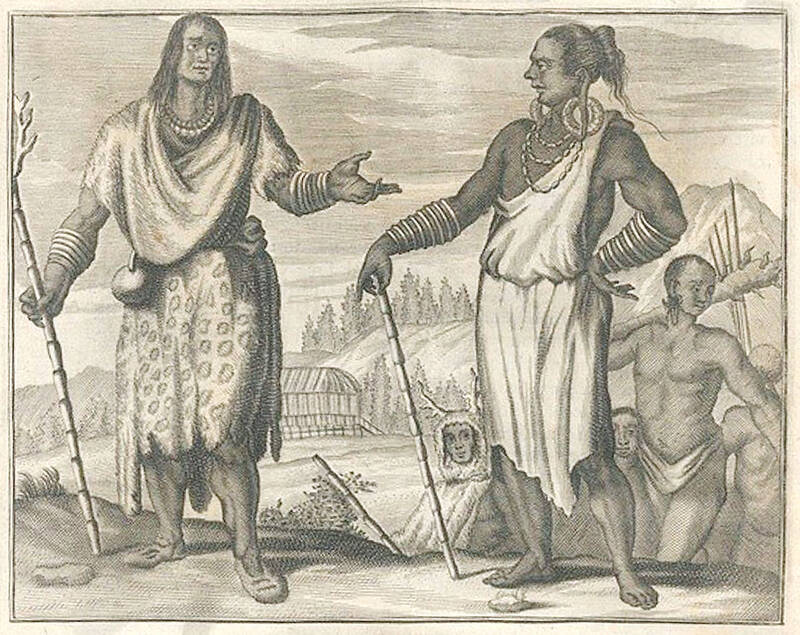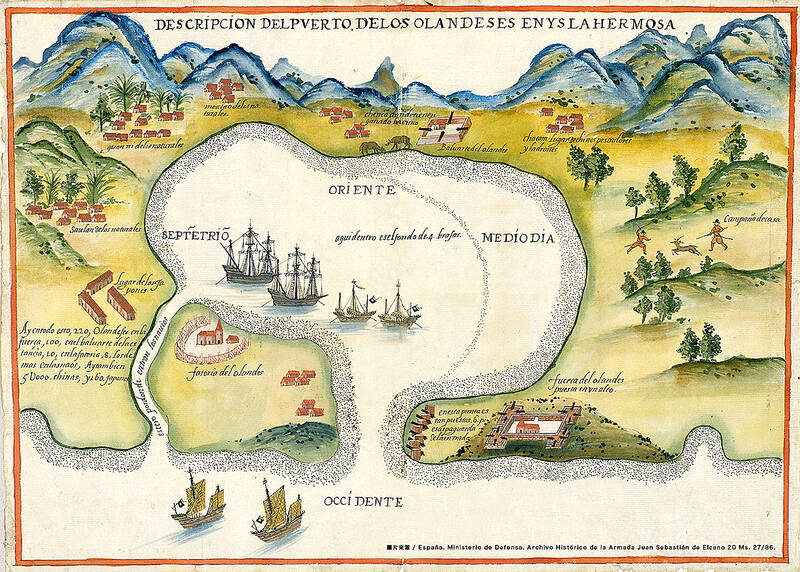Nov. 18 to Nov. 24
Led by a headman named Dika, 16 indigenous Siraya from Sinkan Village, in what is today’s Tainan, traveled to Japan and met with the shogun in the summer of 1627. They reportedly offered sovereignty to the emperor.
This greatly alarmed the Dutch, who were allies of the village. They had set up headquarters on land purchased from the Sinkan two years earlier and protected the community from aggressive actions by their more powerful rivals from Mattau Village.

Photo courtesy of Wikimedia Commons
The Dutch East India Company (VOC) had been embroiled in a bitter trade dispute with Japan, and they believed that the Siraya were tricked or kidnapped into making the journey as political pawns. Governor Pieter Nuyts wrote that the Sinkan were “a simple, ignorant people, who know neither good nor evil.”
Historians, however, beg to differ. Although the Dutch intervened every time, they were unable to completely stop the Mattau people from harassing the Sinkan.
“The Sinkanders knew what they were doing. They had sought friendship and protection from the Dutch. Why not try the Japanese as well?” writes Tonio Andrade in How Taiwan Became Chinese.

Photo courtesy of Wikimedia Commons
The plan to obtain Japanese protection eventually fell through. The Sinkan community was forced to rely solely on the Dutch, who managed to convert a large number of them to Christianity. This paid off for them when on Nov. 23, 1635, Sinkan warriors joined up with VOC forces on their campaign to punish the Mattau for killing 63 Dutch soldiers six years earlier. They torched the entire village and killed 26 residents, finally prevailing in the long-simmering feud.
FIRST CONTACT
The Dutch first encountered the Siraya in October 1623, when they sent an expedition from Penghu to build a fort in Tayouan, in today’s Anping District (安平), Tainan. The four main surrounding villages were Mattau, Soulang, Bakloan and Sinkan. The Mattau were the strongest and exercised considerable influence over the Bakloan, while the Soulang shifted between helping and fighting the Mattau. The Sinkan were the most vulnerable.

Photo courtesy of Wikimedia Commons
The Dutch first approached the Bakloan, who were friendly and willing to help them obtain resources to build the fort. But Mattau warriors showed up to the village daily, obviously unhappy about the foreign presence. On Nov. 25, 1623, about 200 warriors attacked the Dutch crew, leaving three dead and four wounded. Four Siraya were killed and seven were injured.
In January 1624, Mattau and Bakloan warriors tried to burn down the fort, but they were discovered and many men were killed by gunfire and cannons. Under pressure from the Ming Dynasty, the Dutch vacated Penghu for good and moved to Taiwan in August.
The Sinkan and Soulang communities were the first to approach and offer to establish relations, exchanging gifts and inviting VOC staff to stay in their villages. The Bakloan followed suit in November, and finally the Mattau in December. All had hoped to use the Dutch to their advantage against their enemies.
The Dutch decided to ally with the Sinkan, which was closest to Tayouan. In January 1625, they obtained a plot of land with 15 cangan (a type of cloth) and moved their trading post there to serve both Dutch and Chinese merchants. Nine months later, it had grown into a town called Provintien (or Sakam) with 30 to 40 houses, a carpentry shop, kiln, stables and corrals for sheep and cows. There were also fireproof fortifications, two sick rooms and warehouses. Records show that the Dutch did pay the Sinkan rent, at least initially.
BETWEEN THE DUTCH AND JAPANESE
In December 1625, the Mattau raided the Sinkan, also plundering the house of its two Dutch residents. The Dutch, who were already unhappy about the Mattau harboring pirates, forced them to apologize and pay reparations.
However, upon seeing that the Dutch repeatedly sided with Sinkan Village, the Mattau people gave up trying to curry favor with them and began skirmishing with the Sinkan throughout the following year, writes Lee Jui-yuan (李瑞源) in “From Single to Group: The Formation of Sideia in the 17th Century” (單社到社群 — 十七世紀 Sideia 之形成).
The Sinkan and its allies fought back, and again the Dutch tried to mediate, but this time the Mattau community openly challenged the Sinkan and Dutch to battle.
Reluctant to fight, the Dutch stationed troops in Sinkan to scare off the Mattau, but this only made them angrier. As the battle intensified, the Dutch finally opened fire, shocking the Mattau into surrendering. They paid a hefty price of 20 pigs as punishment.
However, Andrade writes that this wasn’t enough for the Sinkan because it didn’t stop Mattau aggression, hence their trip to Japan. Nuyts didn’t hear about their journey until he arrived in Kyoto in August, when he was informed that the relatives of the Sinkan delegation had begged his officers to help retrieve their loved ones.
Nuyts spent 37 days in Tokyo unsuccessfully trying to gain an audience with the shogun, who was only willing to deal with representatives of the Dutch king. Lee writes that the Japanese disputed Nuyts’ claim that the Sinkan had been kidnapped.
A dejected Nuyts returned to Taiwan in December. Meanwhile, the Sinkan received an audience with shogun Tokugawa Iemitsu, who seemed uninterested in their proposal, Lee writes. Lee surmises that the Sinkan were probably trying to persuade Japan to send people to trade and farm in their village so that they would have a vested interest in their safety. However, the truth remains unclear.
THE MATTAU AMBUSH
Meanwhile, the Sinkan evidently wanted to maintain cordial relations with the Dutch, and in November 1627 constructed barracks that could house 10 Dutch soldiers inside their village.
However, Nuyts imprisoned the 11 surviving Sinkan delegates upon their return. Four managed to escape, and resentment toward the Dutch grew. Tensions between the VOC and Japan boiled over in the spring of 1628, culminating in detained Japanese captain Yahei Hamada holding Nuyts hostage at knifepoint in Nuyts’ own office. The Dutch repatriated the Japanese and released the remaining Siraya, who told their people that they were treated well by the Japanese — and how terrible the Dutch were, wrote missionary George Candidus.
It seems that they soon resumed relations, as Candidus was able to continue preaching in Sinkan with favorable results.
In July 1629, Nuyts sent 63 soldiers to Mattau to capture pirates who were allegedly hiding there. The Mattau told them the pirates had fled, and offered to escort Nuyts’ men back to the fort. The kind gesture turned out to be a trap, as the Dutch were ambushed at a river crossing, killing all 63. The attackers suffered no casualties.
The Mattau warriors then headed to Sinkan to kill Nuyts, but he had already left for Tayouan. Instead, they ransacked the area, destroying Dutch property. The Soulang allegedly participated in the ambush and, emboldened by their success, killed a Dutch official living in their village. Nuyts was recalled to Batavia, capital of the Dutch East Indies, and jailed.
The Mattau had hoped that this would cause the Dutch to pack up and leave, but new governor Hans Putnams was determined to bolster their power. They were not ready to exact revenge on the Mattau just yet; instead they burned down the homes of their Bakloan allies on Nov. 23, 1629. The Mattau agreed to a nine-month truce.
At this point, only the Sinkan remained friendly to the VOC.
“The Sinkanders are still friends with us ... at least as far as anyone knows. They still come visit us ... but ... seldom,” Candidus wrote. “From the other villages nobody comes.”
It would take six more years before the Dutch vanquished the Mattau. Until then they remained unwillingly enmeshed in the power struggle between the four villages.
Taiwan in Time, a column about Taiwan’s history that is published every Sunday, spotlights important or interesting events around the nation that either have anniversaries this week or are tied to current events.

Exceptions to the rule are sometimes revealing. For a brief few years, there was an emerging ideological split between the Democratic Progressive Party (DPP) and Chinese Nationalist Party (KMT) that appeared to be pushing the DPP in a direction that would be considered more liberal, and the KMT more conservative. In the previous column, “The KMT-DPP’s bureaucrat-led developmental state” (Dec. 11, page 12), we examined how Taiwan’s democratic system developed, and how both the two main parties largely accepted a similar consensus on how Taiwan should be run domestically and did not split along the left-right lines more familiar in

This month the government ordered a one-year block of Xiaohongshu (小紅書) or Rednote, a Chinese social media platform with more than 3 million users in Taiwan. The government pointed to widespread fraud activity on the platform, along with cybersecurity failures. Officials said that they had reached out to the company and asked it to change. However, they received no response. The pro-China parties, the Chinese Nationalist Party (KMT) and Taiwan People’s Party (TPP), immediately swung into action, denouncing the ban as an attack on free speech. This “free speech” claim was then echoed by the People’s Republic of China (PRC),

As I finally slid into the warm embrace of the hot, clifftop pool, it was a serene moment of reflection. The sound of the river reflected off the cave walls, the white of our camping lights reflected off the dark, shimmering surface of the water, and I reflected on how fortunate I was to be here. After all, the beautiful walk through narrow canyons that had brought us here had been inaccessible for five years — and will be again soon. The day had started at the Huisun Forest Area (惠蓀林場), at the end of Nantou County Route 80, north and east

Specialty sandwiches loaded with the contents of an entire charcuterie board, overflowing with sauces, creams and all manner of creative add-ons, is perhaps one of the biggest global food trends of this year. From London to New York, lines form down the block for mortadella, burrata, pistachio and more stuffed between slices of fresh sourdough, rye or focaccia. To try the trend in Taipei, Munchies Mafia is for sure the spot — could this be the best sandwich in town? Carlos from Spain and Sergio from Mexico opened this spot just seven months ago. The two met working in the